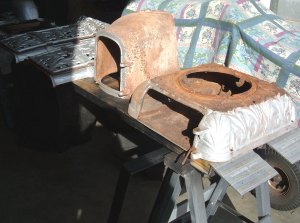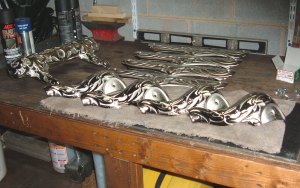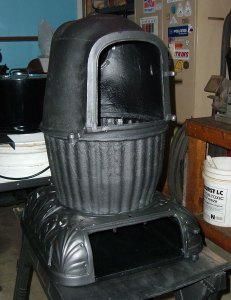This is the King Arizona, not yet restored

King Arizona
The King Arizona is an unusual stove in that it is basically a cast iron furnace inside a cast iron filigree jacket. It’s similar in design to the
Moore’s Air-Tight Heater 403B, except smaller, and has four large mica windows.
The entire stove was spray painted with silver paint, including the mica windows. Actually, that may have helped to preserve the cast iron from rusting.
On the other hand, it does make the sandblasting a bit more difficult! It’s either the rust or the paint, it would seem!
One of its other unique features is that it has an image of a leaping fish in the middle of the filigree design on both sides of the stove.

King Arizona jumping fish
In the center on both sides of the stove, a jumping fish is part of the design in the filigree cast iron jacket.
This part of the stove was never silver or nickel to begin with. Originally it was black cast iron.
We can tell, since when Russ sandblasts the parts, it goes down through the layers of whatever was there originally.
The stove will need to be disassembled entirely, in order to restore it properly. In that process, we find lots of things that might not be evident on first look at the stove…
For example, the fire-pot of the stove is in bad shape. It is badly cracked. And the stove cannot be used safely ever again with a fire-pot in this condition.

King Arizona firepot
So, what to do? It cannot be welded as the cast iron of the firepot is seriously depleted and won’t take a weld that would hold. So, it must be re-cast.
This is done by filling in the cracked areas with bondo, sanding them out and sending to a foundry to be re-cast as a new cast iron piece, which will be as good as the original as far as its usage as a fire pot.
The one thing to consider with re-casting is that there will always be some shrinkage due to the casting process. So, it will be about 1/8 ” less overall dimension than it was before. Sometimes, this will require some additional grinding or welding to fit on the apertures of the stove to hold the fire-pot properly.
Without this essential issue being addressed, this stove would not ever be operational again. The fire pot is the heart of the stove – it must be in good working condition.
The King Arizona disassembled

King Arizona disassembled
Here are some of the pieces of the stove disassembled, minus the trim pieces which were already sent to be plated.
These will be sandblasted and painted, separately, and then re-assembled with high-heat stove cement between each seam, and bolted together using the proper hardware.
During this process we may find more info about the condition of the stove, such as hairline cracks which were covered by the heavy paint. Or, previous repairs that were made to the stove, which were not readily visible when the stove was assembled.
For example, we knew there was a large crack in the base, which had a repair, but was not welded:

Crack in base
Very interesting to see how resourceful this repair was!
Done very simply with four hand pounded rivets; it worked very well to hold that large base together, probably while the stove was still being used.
Here is a picture from the inside of how the riveted original repair was made:

Original crack repair
Very impressive and also a very strong hold for the base.
We will weld this crack, but we are going to leave the original riveted repair. It made the stove permanently stronger, and deserves to be preserved, as well, as a testiment to the ingenuity of the person who made it so perfectly, and with such a minimum of materials or advanced technology.

Arizona furnace and base
The furnace top of the fire pot and the base, before sandblasting and re-painting.
At this point, the pieces will all be sandblasted and painted with high heat stove paint, the fire pot will be sent to the foundry to be re-cast, and the nickel pieces are being re-plated.

King Arizona pieces painted
It is important to paint the pieces as soon as possible after sandblasting because without the protection of the paint, the cast iron will begin to rust immediately.

side panel detail painted
Sometimes there are little ridges in the cast iron from the original mould when it was cast. They may appear to be cracks, but upon closer inspection it is clear that they are just ridges.

furnace piece painted

base painted
Assembly Begins!
Now the pieces are painted and we have the fire pot back from the foundry.

recast fire pot
The fire pot is now brand new cast iron, however, it has undergone about a 1/8 inch overall shrinkage, due to the casting process. So, now it must be adjusted to fit back in the stove. The fitting process usually involves some grinding, and sometimes some welding, as well. And, of course, the fire pot is then painted.

grinding recast firepot
And, our nickel pieces are back from the plater.

nickel plated pieces
So now it really is time for assembly. Here is the fire pot, furnace and base assembled. The seams must be lined with high heat stove cement and the bolts attached before the cement sets.This is the heart of the stove, and everything must be right with it.

fire pot and furnace assembled
Now things start to go together rather quickly. Here, the front panel is assembled to the stove.

front panel assembled
And here, the side and back panels are assembled to the stove.

side and back panels assembled
Putting it all together
Time to set the body of the stove on its base. The body, or main part of the stove, is not sealed or bolted to the base, and can be taken off the base again for shipping.

set on base
Next: the boot rails and nameplate. The nameplate is bolted on and the boot rails fit into slots on the sides of the stove, and can simply be lifted off at any time. (which may be why so many antique stoves are missing their boot rails!

boot rails and nameplate
Adding the doors, swing top and finial. The main door has had its mica windows replaced and its exterior grid plated; the ash door has its nickel-plated vent; the swing top has been plated and the finial restored to its original copper and nickel.
The King Arizona restored – Yay!!

King Arizona restored























Thanks for posting this process…great info. Any tips on the choice of new bolts and nuts used to reassemble stove? Stainless steel?
I have just bought a 1905 Herald oak 14 parlor stove and am curious if any old pics/catalogs/ books exist with original pics….I want to see what was originally nickel.
Again, thanks for posting.
By: Paul on May 30, 2011
at 9:33 am
Use stove bolts with square nuts and not stainless steel because stainless will not hold the stove paint, unless you sandblast the heads. Only use stainless steel for the nickel pieces. As for the original catalog ads, etc – they are not easy to find, but we have put some tips on researching your antique stove on our website at:
http://gingercreekstoves.com/Research_and_restoration.html
By: gingercreekstoves on June 1, 2011
at 6:17 pm
Wow. I never took time to look at this super interesting restoration job. Very impressive and well done. Also you made very good photos showing all details…Felicitations for the nice work,
From nortcan, Qc,canada
By: pierre Boucher on July 1, 2011
at 9:35 pm
Thank you Pierre! We are waiting to finish the stove, (and the post) for one piece of nickel to come back from the plater. We had decided at the last minute to plate the exterior grate of the door, so that it would be more visually balanced. As far as we can tell, it was not originally plated, so that is sometimes a decision to be made during restoration. The stove is otherwise finished, and I will be posting the rest of the restoration pictures within the next week.
By: gingercreekstoves on July 3, 2011
at 5:39 pm
Very well done! Is the stove in working condition and is it for wood or coal?
By: nortcan on July 11, 2011
at 12:24 pm
Yes , it’s 100% restored and in working condition. It was made to use with coal, but can be used with wood as well.
All aspects of the stove are restored to work as they would have when it was newly offered, around 100 years ago.
By: gingercreekstoves on July 12, 2011
at 7:39 pm
These stoves were meant to burn Anthracite Coal and are very efficient if that fuel is used. Stoves like the Globe Hot Blast is meant to burn Bituimous Coal, but; Anthracite would work equally well. The true efficiency and capacity of these superior designs can’t be realized when burning wood in them. I live up in the Pennsylvania Poconos and depend on a Glenwood Base Heater for 100% of my heating needs. I just bought an Our Glenwood Base Heater No 9 as a smaller stove for the Fall and early spring, and just because I love these coal burning masterpieces from the Turn Of the Century. I have started a Glenwood Craze up here. Everybody that sees the Glenwood in action is amazed at its high efficiency and ingenious engineering.
By: Anonymous on September 6, 2011
at 8:24 pm
Yes, the hot blast stoves were made primarily to use coal, as were the baseheaters. However, they can be used effectively with hardwood, as well.
(The King Arizona is neither a hot blast stove nor a baseheater)
In the original advertisement for the New Globe Hot Blast, (which is their improved version of the ‘Globe Hot Blast’), it says,”We claim that our new heater will burn any kind of fuel more economically, will consume the smoke and soot more completely, will heat the base, floor and room more thoroughly, and will hold fire just as long as any heater ever made.”
They also state that it efficiently “burns slack, and all grades of hard and soft coal”.
Coal naturally burns hotter and more slowly than wood, and hard coal, anthracite, burns the hottest and longest. It also therefore, takes a high toll on the stove itself, as the hotter the cast iron is heated, and, for longer periods of time, the faster the parts exposed to the direct heat will become depleted and subject to hairline cracks, and eventual breakage, such as the grates and firepot.
The Glenwood stoves are wonderful stoves, too. And a baseheater is a different type of heating stove than a hot blast heating stove. The baseheater will circulate the heat back down to the base of the stove, giving it more time to heat the room, before going out the chimney.
A large baseheater will probably put out more heat than any other type of stove, especially if it is used with coal, and especially hard coal.
The hot blast stove, supplies air underneath and around the fuel through the firepot itself, which is double walled and ventilated, so that when the special hot blast vent is opened, by degrees, the air goes directly under and around the fuel, making it burn hotter and more quickly, without smoldering, and without producing soot and smoke. That is probably because it can be difficult to get coal started burning, and keep it going at an optimal burn. The same can be true of hardwood or wood that is not adequatedly seasoned.
So, both types of heaters have their advantages .
By: gingercreekstoves on September 7, 2011
at 3:04 pm
This article is very helpful! I am currently restoring a Moore Airtight 403b and it is very similar in design. My one questions for you is how can i go about removing rusted screws that are striped and or sheered off. I have removed the top part of the Fire pot and had bolts snap on me. I have heated them up with torch but still not budging. Do i have to re-tap holes?
By: mike on July 10, 2013
at 4:56 pm
Hi Mike, Yes, the Moore’s 403B is very similar in design to the King Arizona. On the Moore’s, the four thumb screws on the back of the stove, with wingnuts, would need to be re-threaded. The other bolts can be just cut and replaced. For the firepot, when you sandblast, the bolts will loosen and you can tap them out.
By: gingercreekstoves on July 12, 2013
at 10:32 am
Thanks for the info! I had no trouble with the 3 thumb screws they all backed out great except for one. Bolts on fire pot snapped on a few turns but will drill out the existing screw heads rusted in place. Any tips on blasting media? Glass? Sand?
By: mike on July 12, 2013
at 11:07 am
You should never use sand or glass to sandblast, silica is very bad to breathe in, even one time. We use black diamond, which is coal slag. Also not great to breathe in. You should have an air-supplied hood to sandblast, so you have fresh air supply. That requires a dedicated air pump for the hood.
By: gingercreekstoves on July 12, 2013
at 7:44 pm
Thanks again for the tips, ill use the black diamond for sure!
By: mike on July 13, 2013
at 11:53 am
Any suggestions on what type of stove cement to use during re-assembly process?
By: mike on October 10, 2013
at 3:49 pm
hey mike, i too am restoring a stove. i am wondering which type of cement you used for reassembly. and did you make gaskets?
By: bill on October 9, 2016
at 7:31 am
I enjoy what you guys are up too. This kind of clever work and
reporting! Keep up the amazing works guys I’ve incorporated
you guys to our blogroll.
By: floor sanding South East London on April 5, 2014
at 5:10 am
Well researched post, thanks for sharing.
By: widespreadind on June 9, 2014
at 9:57 am
Hey there. This is a wonderful article! I may be coming into a beautiful King Arizona. It’s in really great shape. I’m trying to work out a trade for something but I do t what is fair as I don’t know what the King Arizona could be worth. Can you give me an idea! Like I said, it looks almost brand new. Any insight you could offer would be greatly appreciated. Thank you kindly in advance. And thank you for posting this restoration process…very interesting!
By: Heather Keith on March 27, 2015
at 6:59 pm
Hi Heather,
We generally don’t do evaluations or appraisals on the blog site here but you are welcome to contact us on the regular website email and I will be glad to discuss our evaluation process.
By: gingercreekstoves on March 28, 2015
at 9:42 am
Is there a superior kind of stove cement? I have resealed the seams of my old vermont castings vigilant so many times and there is always another small leak of smoke that makes the whole house smell bad and means i have to open the draft to burn the wood which is of course, nuts!
By: Lorey on January 22, 2017
at 9:52 am
As far as we know, there isn’t any superior kind of stove cement. It is just high heat mortar. If it doesn’t work to seal your stove, then the stove likely has other problems. Of course, adding it on top of seams that probably have dried out over time probably won’t make a complete seal. That’s why people restore stoves. Don’t know if a Vermont Casting Vigilant can be restored that way since it isn’t an antique stove.
By: gingercreekstoves on January 22, 2017
at 7:18 pm